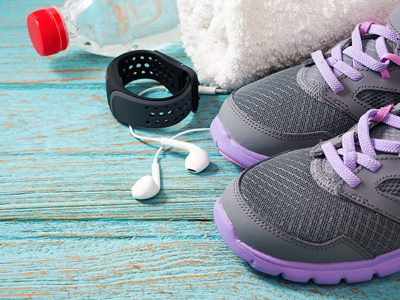How an Exercise Routine Can Aid in Long-Term Recovery
 Following the initial stages of treatment for substance abuse, establishing an exercise routine can be a beneficial addition to your recovery.
Following the initial stages of treatment for substance abuse, establishing an exercise routine can be a beneficial addition to your recovery.
While you might be thinking that committing to an exercise routine is way too much to handle when newly sober, you might be surprised at how quickly the immediate benefits change your mind.
According to an article published in Frontiers in Psychiatry Front, preliminary research suggests that exercise can provide benefits for long-term recovery by decreasing risk associated with relapse and craving as well as improving general health aspects that have been negatively affected by substance abuse, such as:
- Interrupted sleep
- Cognitive function
- Mood
- Weight gain
In addition to the general health benefits, routine exercise may aid you in sustaining long-term recovery.
Exercise builds self-confidence
Like with anything you do, the more you do it, the better you get. Exercise provides a physical way to both feel and see self-transformation. As you witness your progression, you will feel accomplished and motivated for further self-improvement.
Exercise gives you a “natural” high
Exercising, especially cardio workouts like running, are known to provide you with a “natural” high. That is because working out increases the levels of endorphins in your brain. Endorphins are a group of neurotransmitters that help the body relieve pain and stress. When endorphins increase, you feel a rush of pleasure.
Exercise prevents binging
People who have suffered from substance abuse have likely gone through periods in which they used a large amount of drugs in a short amount of time. Binges often lead to dangerous situations including medical emergencies or even death.
According to preliminary research, routine exercise has been shown to reduce the risk of binging.
Exercise allows you a break from your daily life
Exercise is a time for you to work on the physical level. An exercise routine should devote a certain amount of time per week to concentrating on your body.
This time shouldn’t feel like a burden. It should be a time when you allow yourself to stop thinking about work, relationships, your past, and so on. It’s not that those things don’t matter, but everyone deserves a break.
Exercise allows you to connect more fully with your body
Much of recovery focuses on the mental and emotional aspects. But we aren’t just floating heads. There is a relationship between the mind and body. Improving one motivates you to improve the other.
Sometimes what can’t be expressed through words or other means can be expressed through the body. This goes back to that old idea of punching a pillow. Exercising is an outlet for built up tension that we accrue over time.
A word of caution
Don’t forget to take breaks and not overdo it. You feel good one day running and then suddenly you are ten miles from home. Don’t keep pushing. Call for a ride.
Be careful not to replace substance with exercise. Part of recovery is learning balance. Too much of anything is no good.
Some signs of overdoing it are:
- Malnutrition
- Injury
- Dangerous weight loss
- Avoiding social and family gatherings in lieu of “needing to work out”
- Turning your back on responsibilities
The best thing about exercise is that there are so many choices. One of the most convenient (weather permitting) and economic exercises is walking. With a sturdy pair of sneakers, you can walk your way toward better overall health.
Increasing a regular walk to a brisk walk, in fact, can provide multiple health benefits. An article published by the Mayo Clinic, suggests that a routine of brisk walking can help:
- Improve mood
- Manage medical conditions such as Type 2 Diabetes
- Improve balance and coordination
- Strengthen bones and muscles
You also have the ability to control the intensity. For more of a workout, increase your speed and distance.
Other types of exercise you might consider are:
- Bicycling
- Yoga
- Rock climbing
- Pilates
- Aerobics videos
- Swimming
- Tennis
- Martial arts
- Weight lifting
Exercise doesn’t have to be expensive. In fact, there are a plethora of online YouTube videos that vary in length and ability. You can find a custom video that fits your needs. One of my personal favorites is Lumowell’s channel, where you can find videos that will cater to your needs.
If you are not sure what kind of exercise you would best suit you, experiment. Exercise doesn’t have to be a cumbersome darkness that you slowly edge toward. It can be fun!
No matter what you choose, start slow and work your way up. You may be inclined to jump right in and forge ahead fast, but in order to create a routine of longevity, a steady, cautious approach is best. In the words of one of my best friends who competes in numerous triathlons per year, “Quit while you still have steam.”
You may also have the opportunity to incorporate an exercise routine while living at an in-patient rehab center. As with any added workout routine, it is important to check with your physician and/or counselors to find what works best for you. Don’t forget to include an adequate warm-up and cool-down as well as use correct form and gear.

For more information about programs offered at Fair Oaks Recovery Center, please call us today at
(888) 576-0222.
BrightEdge\BEIXFClient Object
(
[connectTime:BrightEdge\BEIXFClient:private] => 53
[_get_capsule_api_url:BrightEdge\BEIXFClient:private] => https://ixfd1-api.bc0a.com/api/ixf/1.0.0/get_capsule/f00000000296879/018198253?client=php_sdk&client_version=1.5.12&base_url=https%3A%2F%2Ffairoaksrecoverycenter.com%2Fblog%2Fhow-an-exercise-routine-can-aid-in-long-term-recovery%2F&orig_url=https%3A%2F%2Ffairoaksrecoverycenter.com%2Fblog%2Fhow-an-exercise-routine-can-aid-in-long-term-recovery%2F&user_agent=Mozilla%2F5.0+AppleWebKit%2F537.36+%28KHTML%2C+like+Gecko%3B+compatible%3B+ClaudeBot%2F1.0%3B+%2Bclaudebot%40anthropic.com%29
[displayCapsuleUrl:BrightEdge\BEIXFClient:private] => https://ixfd1-api.bc0a.com/api/ixf/1.0.0/get_capsule/f00000000296879/018198253
[capsule:BrightEdge\BEIXFClient:private] => BrightEdge\Capsule Object
(
[accountId:protected] => f00000000296879
[publishingEngine:protected] => ixf-compiler
[dateCreated:protected] => 1.73632801687E+12
[datePublished:protected] => 1.73632801687E+12
[version:protected] => 1.0.0.0
[capsuleNodeList:protected] => Array
(
[0] => BrightEdge\Node Object
(
[type:protected] => bodystr
[dateCreated:protected] => 1.7363280185E+12
[datePublished:protected] => 1.73632801687E+12
[publishingEngine:protected] => link-block
[engineVersion:protected] => 1.0.0.0
[metaString:protected] =>
[content:protected] =>
[feature_group:protected] => body_1
[redirectType:BrightEdge\Node:private] =>
[redirectURL:BrightEdge\Node:private] =>
)
[1] => BrightEdge\Node Object
(
[type:protected] => headstr
[dateCreated:protected] => 1.73632801857E+12
[datePublished:protected] => 1.73632801687E+12
[publishingEngine:protected] => app-js
[engineVersion:protected] => 1.0.0.0
[metaString:protected] =>
[content:protected] =>
[feature_group:protected] => _head_open
[redirectType:BrightEdge\Node:private] =>
[redirectURL:BrightEdge\Node:private] =>
)
)
[configList:protected] => stdClass Object
(
[page_groups] => Array
(
[0] => stdClass Object
(
[priority] => 1
[include_rules] => Array
(
[0] => .*fairoaksrecoverycenter\.staging\.tempurl\.host\/.*
)
[name] => staging
[exclude_rules] => Array
(
)
)
[1] => stdClass Object
(
[priority] => 2
[include_rules] => Array
(
[0] => fairoaksrecoverycenter\.com
)
[name] => Global Settings
[exclude_rules] => Array
(
)
)
)
)
[pageGroupNodes:protected] => Array
(
[0] => BrightEdge\Node Object
(
[type:protected] => bodystr
[dateCreated:protected] => 1.7363280185E+12
[datePublished:protected] => 1.73632801687E+12
[publishingEngine:protected] => link-block
[engineVersion:protected] => 1.0.0.0
[metaString:protected] =>
[content:protected] =>
[feature_group:protected] => body_1
[redirectType:BrightEdge\Node:private] =>
[redirectURL:BrightEdge\Node:private] =>
)
)
[allPageGroupNodes:protected] => stdClass Object
(
[excluded_config] => Array
(
[0] => stdClass Object
(
[feature_group] => body_1
[engine_version] => 1.0.0.0
[content] =>
[date_published] => 1736328016866
[date_created] => 1736328018500
[type] => bodystr
[publishing_engine] => link-block
)
)
[staging] => Array
(
[0] => stdClass Object
(
[feature_group] => body_1
[engine_version] => 1.0.0.0
[content] =>
[date_published] => 1736328016866
[date_created] => 1736328018500
[type] => bodystr
[publishing_engine] => link-block
)
)
[Global Settings] => Array
(
[0] => stdClass Object
(
[feature_group] => body_1
[engine_version] => 1.0.0.0
[content] =>
[date_published] => 1736328016866
[date_created] => 1736328018503
[type] => bodystr
[publishing_engine] => link-block
)
)
)
[pageGroup:protected] => Global Settings
)
[_capsule_response:BrightEdge\BEIXFClient:private] => {
"account_id": "f00000000296879",
"date_published": 1736328016866,
"key": "-0",
"is_universal_capsule_enabled": "false",
"capsule_version": "1.0.0.0",
"engine_version": "1.0.0.0",
"version": 2,
"date_created": 1736328016866,
"nodes": [
{
"feature_group": "body_1",
"engine_version": "1.0.0.0",
"content": "",
"date_published": 1736328016866,
"date_created": 1736328018503,
"type": "bodystr",
"publishing_engine": "link-block"
},
{
"feature_group": "_head_open",
"engine_version": "1.0.0.0",
"content": "\n\n\n",
"date_published": 1736328016866,
"date_created": 1736328018572,
"type": "headstr",
"publishing_engine": "app-js"
}
],
"config": {
"page_groups": [
{
"priority": 1,
"include_rules": [
".*fairoaksrecoverycenter\\.staging\\.tempurl\\.host\\/.*"
],
"name": "staging",
"exclude_rules": []
},
{
"priority": 2,
"include_rules": [
"fairoaksrecoverycenter\\.com"
],
"name": "Global Settings",
"exclude_rules": []
}
]
},
"publishing_engine": "ixf-compiler",
"page_group_nodes": {
"excluded_config": [
{
"feature_group": "body_1",
"engine_version": "1.0.0.0",
"content": "",
"date_published": 1736328016866,
"date_created": 1736328018500,
"type": "bodystr",
"publishing_engine": "link-block"
}
],
"staging": [
{
"feature_group": "body_1",
"engine_version": "1.0.0.0",
"content": "",
"date_published": 1736328016866,
"date_created": 1736328018500,
"type": "bodystr",
"publishing_engine": "link-block"
}
],
"Global Settings": [
{
"feature_group": "body_1",
"engine_version": "1.0.0.0",
"content": "",
"date_published": 1736328016866,
"date_created": 1736328018503,
"type": "bodystr",
"publishing_engine": "link-block"
}
]
}
}
[allowDirectApi:BrightEdge\BEIXFClient:private] => 1
[debugMode:BrightEdge\BEIXFClient:private] =>
[disableRedirect:BrightEdge\BEIXFClient:private] =>
[deferRedirect:BrightEdge\BEIXFClient:private] =>
[_normalized_url:BrightEdge\BEIXFClient:private] => https://fairoaksrecoverycenter.com/blog/how-an-exercise-routine-can-aid-in-long-term-recovery/
[_original_url:BrightEdge\BEIXFClient:private] => https://fairoaksrecoverycenter.com/blog/how-an-exercise-routine-can-aid-in-long-term-recovery/
[client_user_agent:BrightEdge\BEIXFClient:private] => Mozilla/5.0 AppleWebKit/537.36 (KHTML, like Gecko; compatible; ClaudeBot/1.0; +claudebot@anthropic.com)
[errorMessages:protected] => Array
(
)
[profileHistory:protected] => Array
(
[0] => Array
(
[0] => constructor
[1] => 53
)
[1] => Array
(
[0] => getFeatureString
[1] => 0
)
[2] => Array
(
[0] => getFeatureString
[1] => 0
)
)
[config] => Array
(
[sdk.environment] => production
[api.endpoint] => https://ixfd1-api.bc0a.com
[sdk.charset] => UTF-8
[sdk.account] => f00000000296879
[sdk.connectTimeout] => 1000
[sdk.socketTimeout] => 1000
[sdk.crawlerConnectTimeout] => 1000
[sdk.crawlerSocketTimeout] => 1000
[whitelist.parameter.list] => ixf
[forcedirectapi.parameter.list] => ixf-api|ixf
[flat.file] => true
[sdk.proxyPort] => 0
[sdk.proxyProtocol] => http
[crawler.useragents] => google|bingbot|msnbot|slurp|duckduckbot|baiduspider|yandexbot|sogou|exabot|facebot|ia_archiver|brightedge
[content.base.path] => /nas/content/live/fairoaksrecove/wp-content/themes/valley
[diagnostic.type] => full_encrypted
[diagnostic.string] => 1
[capsule.mode] => remote.prod.capsule
[page.independent] => false
)
)
 Following the initial stages of treatment for substance abuse, establishing an exercise routine can be a beneficial addition to your recovery.
Following the initial stages of treatment for substance abuse, establishing an exercise routine can be a beneficial addition to your recovery.


